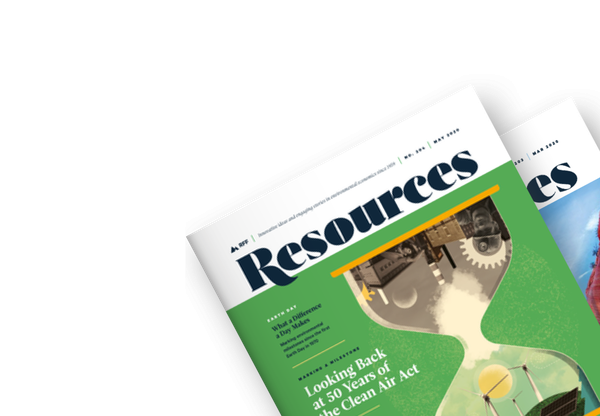A new collaboration between Resources for the Future and partner institutions creates a space for students to hone their research on critical minerals by working with each other, established experts in the field, and policymakers.
In 2024, Resources for the Future (RFF), with researchers at Carnegie Mellon University, Stanford University, and Colorado School of Mines, established the Critical Minerals Research Lab. For PhD students who are working on policy-relevant topics in critical minerals research around the clean energy transition, this lab provides the opportunity to connect, collaborate, and receive feedback from a nationwide interdisciplinary group of students. By participating in the lab, these scholars will be able to enhance the policy relevance and impact of their critical minerals research. The overarching goal of the lab is twofold: to provide students with an opportunity to present their work and receive feedback from scholars with diverse points of view and academic training, and to create a collaborative community of PhD students who are interested in similar topics.
Some of the students already have begun coming together on relevant research, including an exploration of the EU Corporate Sustainability Due Diligence Directive and related implications for electric vehicle and battery manufacturers (with Anthony Cheng and Vaios Triantafyllou), and an analysis of the economic, legal, and social trade-offs of deep-sea mining compared to terrestrial mining (with Gabriella Berman and Elizabeth Echavarria). Once finalized, these reports will be published through RFF.
The lab also provides the opportunity for lab scholars to hear from invited experts in the field. The experience will culminate in a public conference in June, when the scholars will present their work to a broad audience that includes policymakers.
After a successful inaugural year, we have decided to continue this effort with more student cohorts. The second-year cohort of lab scholars will be announced soon. Here, we highlight six of the inaugural lab scholars to give a sense of who these students are, what they are excited about, and how the lab has fostered their research methods and interests.

Hometown: Maui, Hawai’i
Student Bio: Third-year PhD student (recently finished the JD portion of a joint JD/PhD degree) in the Environmental Science and Policy program at the University of Miami
Work and Interests: I am a marine biologist working at the intersection of marine sciences and international environmental law. I’m interested in developing marine policy that effectively balances marine conservation with global mineral needs.
Why did you choose to study deep-sea mining? What do you think is one of the most challenging issues related to public policy around mineral extraction in the deep sea?
As a deep-sea marine scientist, I saw not just a need for scientists who could leverage their scientific training to work in law and policy on this critical issue, but also a need for those with law and policy training to have a strong understanding of science. However, gaps in scientific knowledge about deep-sea ecosystems make it difficult to develop policies and regulations that adequately anticipate potential impacts from deep-sea mining—and to fully understand related trade-offs between impacts (environmental and social) and benefits (economic and social). Deep-sea mining is an increasingly important and controversial topic. Research on these knowledge gaps is essential at this time, when scientists are making incredible discoveries in the ocean and the world is evaluating whether to develop an industry that could significantly—and, in some instances, irreversibly—impact these crucial ecosystems.

Hometown: Takoradi, Ghana
Student Bio: Second-year PhD student in mining engineering at Missouri University of Science and Technology
Work and Interests: I am a dedicated researcher with expertise in critical minerals, clean energy technology, and mineral economics. I leverage interdisciplinary approaches to global challenges while passionately balancing my career and motherhood, as a proud mother of two beautiful girls.
How has participation in the Critical Minerals Research Lab helped you refine your research agenda?
Participating in the Critical Minerals Research Lab has been an incredibly enriching and transformative experience, fueling my passion for tackling the challenges of the sustainable mineral market in the clean energy transition. Collaborating with brilliant experts and engaging in dynamic, interdisciplinary discussions has sharpened my understanding of complex issues like geopolitical risks, technological breakthroughs, and environmental impacts. The lab’s commitment to evidence-based research has furthered my understanding of the importance of leveraging advanced tools, such as modeling and policy evaluation, which empowers me to approach my work with greater rigor and confidence. Most importantly, the lab’s focus on driving real-world solutions has energized me to align my research with meaningful, actionable strategies that address some of the most pressing sustainability challenges of our time.

Hometown: Santiago, Chile
Student Bio: Third-year PhD student in energy systems at the University of California, Davis
Work and Interests: I’m an engineer and statistician from Chile, working on quantitatively modeling the demand and supply of critical minerals in the energy transition.
Which policies that address battery recycling do you think would be most beneficial in helping to achieve a cost-effective circular economy for electric vehicles?
A robust recycling market will provide many benefits, not just by reducing the amount of primary minerals we extract from the ground (and their associated mining impacts), but also by providing a sustainable long-term supply of minerals that is less geographically concentrated and prevents the negative environmental impacts that result from the inadequate disposal of batteries. Recycling policies need to tackle multiple issues simultaneously: setting collection targets for end-of-life batteries, accounting for secondhand vehicle trade with battery passports, setting incremental targets for material recovery, and implementing standards for minimum recycled content to support a secondary materials market. These policies will not only minimize end-of-life impacts, but also enable technology innovation and economies of scale for the industry. Finally, other actions will be needed across the waste hierarchy; for instance, reducing primary battery demand by applying strategies such as energy efficiency, or promoting second-life batteries by repurposing them for grid storage.

Hometown: Inner Mongolia, China
Student Bio: Third-year PhD student in environmental engineering at Pennsylvania State University; non-degree graduate student at the Princeton School of Public and International Affairs
Work and Interests: In my research, I model the societal aspects of decarbonization, and in my life, I focus on cats and dogs.
How has your interdisciplinary background in environmental engineering, psychology, and interactions with policymakers helped inform your approach to researching critical minerals?
My fields may seem distinct, but they go surprisingly well with each other for critical minerals–related policy analysis. My foundation in environmental engineering allows me to bring to the lab a strong understanding of environmental systems. My research with integrated assessment modeling has deepened my appreciation of the vital role of critical minerals in the clean energy transition. Complementing these technical perspectives, my background in psychology offers valuable insights into the rationality—and sometimes irrationality—of the policymakers and advocates who shape these policies.
Together, these disciplines enable me to analyze the social dimensions of critical minerals, recognizing that relevant issues related to the environment, international politics, climate, and economics ultimately center on people. As public involvement grows in decisionmaking processes, this integrated perspective will be essential for addressing the complex challenges of the field.

Hometown: Sandy, Utah
Student Bio: Fourth-year PhD student in engineering and public policy at Carnegie Mellon University
Work and Interests: I focus on analyzing clean technologies and the policies that support them. I’m currently working in the context of the supply chains, vulnerabilities, and incentives for critical minerals, along with the broader impacts of technology adoption and decarbonization in the electric vehicle industry.
How do you think the interdisciplinary nature of the Critical Minerals Research Lab will influence your approach to studying mineral supply chains?
My work on mineral supply chains for electric vehicle batteries has required a systems-level perspective, and the interdisciplinary nature of the lab aligns well with this approach. Interacting with fellows from different fields has reaffirmed the importance of integrating technical and policy considerations, which is essential for addressing real-world issues with supply chains. Asking folks detailed questions about the lithium supply chain, so I can share in their perspectives and existing knowledge, has been helpful in narrowing my current scope of work and increasing my own understanding. I look forward to continuing to engage with my cohort of fellows beyond our tenure in the lab.

Hometown: Bafoussam, Cameroon
Student Bio: Fifth-year PhD student in sustainability studies at West Virginia University
Work and Interests: My research addresses the sustainable extraction of natural resources, with a goal of developing strategies to ensure that mining drives economic and social benefits. I am particularly interested in finding ways to engage diverse stakeholders—from policymakers to local communities—and incentivize equitable and sustainable resource management.
Extracting minerals from existing sources of coal waste provides an opportunity for traditional coal-based communities to participate in the clean energy transition. What policies are you exploring that could help these communities take advantage of the opportunity?
For coal communities, extracting rare earth elements from acid mine drainage is a game changer, transforming a long-standing and costly pollution problem into an economic opportunity. But for this objective to succeed, policies must attract investment, ensure local benefits, and develop a regional market and processing industry for rare earth elements.
First, companies need legal certainty. Clear ownership rights for extracted rare earth elements (like those defined in House Bill 4003 on the Abandoned Mine Lands and Reclamation Act in West Virginia, which clarifies who profits from rare earth elements that are extracted from mine drainage) aim to encourage the treatment of acid mine drainage by ensuring that the entities involved are able to make a profit from extraction.
Second, keeping these jobs local is a key factor to success. Partnering with trade schools and colleges to train local community members and retrain former coal workers can equip people with the needed skills to participate. Finally, building domestic processing infrastructure for rare earth elements ensures that the extraction of minerals contributes to local economies. For generations, these towns have powered the United States. With the right policies, these same communities can lead a clean energy future.






